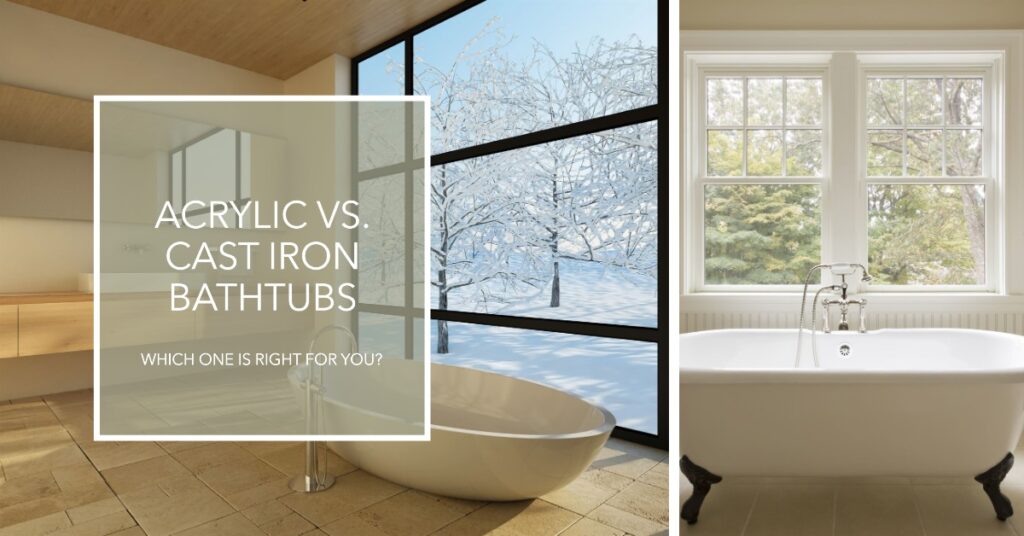
If you’re planning a bathroom remodel, choosing the right bathtub is one of the most important decisions you’ll make. The bathtub is often the centerpiece of the bathroom, and it’s where you’ll spend a lot of time relaxing and unwinding. Two of the most popular materials for bathtubs are acrylic and cast iron, each with its own unique advantages and disadvantages. In this article, we’ll explore the differences between these two materials and help you choose the best option for your bathroom.
Comparison of Acrylic and Cast Iron tub properties
| Properties | Cast Iron Bathtubs | Acrylic Bathtubs |
| Material | Iron coated with porcelain enamel | Polymer-based material (PMMA) |
| Durability | Highly durable and resistant to damage | Less durable than cast iron |
| Surface Finish | Porcelain enamel provides a long-lasting finish that is resistant to scratches and stains | Requires special care to maintain the surface finish |
| Heat Retention | Retains heat well, keeping the water warmer for longer periods of time | Doesn’t retain heat as well as cast iron |
| Weight | Heavy, making installation more difficult and requires proper floor support | Lightweight, making it easier to install |
| Cost | More expensive than acrylic | Less expensive than cast iron |
| Maintenance | Requires regular cleaning and rust protection | Requires special cleaning solutions to maintain the finish |
Acrylic Bathtubs
Acrylic bathtubs are made from a material called polymethyl methacrylate (PMMA), a type of plastic that is lightweight and flexible. Acrylic bathtubs are popular because they come in a wide range of styles and sizes, making them a versatile choice for any bathroom. They are also resistant to rust and discoloration, which means they maintain their luxurious appearance for years to come. Acrylic bathtubs are typically less expensive than cast iron options, which makes them a popular choice for homeowners on a budget.
Some of the best applications for acrylic bathtubs include free-standing options, which can add a modern and sleek look to your bathroom. They also work well for smaller bathrooms where a lighter and more compact bathtub is needed. However, if you’re looking for a bathtub with more durability and resistance to damage, cast iron may be a better choice.
III. Cast Iron Bathtubs
Cast iron bathtubs have been a popular choice for homeowners for over a century. They are known for their durability, strength, and longevity. The material used in cast iron bathtubs is molten pig iron, which is then poured into a mold and coated with enamel. This coating gives the bathtub a shiny, polished finish.
Upgrade your bathroom with the perfect cast iron bathtub that fits your needs: The Ultimate Guide to Finding the Best Cast Iron Bathtub
Advantages of Cast Iron Bathtubs
One of the main advantages of cast iron bathtubs is their durability. They are incredibly strong and resistant to damage. Cast iron bathtubs also have a long-lasting finish that can withstand daily wear and tear. The enamel coating on a cast iron bathtub is resistant to scratches and chipping, making it an excellent choice for families with children or pets.
Cast iron bathtubs are also versatile and come in a variety of styles and designs. One of the most popular styles is the clawfoot bathtub, which adds a classic, vintage look to any bathroom. They are also available in freestanding and built-in models, making them suitable for any bathroom layout.
Resurface your old cast iron tub and give it a new life with our step-by-step guide: How to Resurface a Cast Iron Tub
For more information on cast iron bathtubs, check out our Ultimate Guide to Finding the Best Cast Iron Bathtub.
IV. Comparison of Cast Iron and Acrylic Bathtubs
When deciding between cast iron and acrylic bathtubs, it’s essential to compare the materials’ advantages and disadvantages. While both materials have their pros and cons, there are some significant differences to consider.
In terms of composition, cast iron bathtubs are made of molten pig iron, while acrylic bathtubs are made of polymethyl methacrylate (PMMA). Cast iron bathtubs are more durable and resistant to damage, while acrylic bathtubs are more flexible and easier to install.
For a detailed comparison of cast iron and acrylic bathtubs, including cost, maintenance requirements, and more, check out our article on Cast Iron vs. Acrylic Bathtubs.
V. Maintenance of Cast Iron and Acrylic Bathtubs
Proper maintenance of your bathtub is essential to keep it looking great and functioning well. While cast iron and acrylic bathtubs have different cleaning and maintenance requirements, both can be easily maintained with some basic upkeep.
Get expert advice on which tiles are best for your shower walls: Ceramic, Porcelain, Glass or Natural Stone: Which Tiles are Best for Shower Walls?
A. Cleaning and Removing Mineral Deposits
Both cast iron and acrylic bathtubs can develop mineral deposits over time, which can be unsightly and difficult to remove. To clean your bathtub and remove mineral deposits, follow these steps:
- Mix equal parts of water and white vinegar in a spray bottle.
- Spray the solution onto the affected areas of the bathtub and let it sit for 15-20 minutes.
- Scrub the bathtub with a soft-bristled brush or non-abrasive sponge.
- Rinse the bathtub thoroughly with warm water.
For tougher mineral deposits, you may need to repeat this process or use a commercial cleaner specifically designed for bathtubs.
Transform your bathroom into a luxurious spa-like oasis with the best bathtub and shower wall options: The Best Bathtub & Shower Wall Options for Your Bathroom
B. Other Maintenance Tips
In addition to regular cleaning, here are some other tips to help maintain the appearance and functionality of your bathtub:
- Avoid using abrasive cleaners or scrubbers on your bathtub, as they can scratch the surface and damage the finish.
- Avoid using hot water when cleaning acrylic bathtubs, as it can cause the material to warp or melt.
- Consider resurfacing your cast iron bathtub if it becomes damaged or worn over time. Resurfacing can be a cost-effective alternative to replacing the entire bathtub.
FAQs
Acrylic and cast iron tubs both have their pros and cons. Acrylic tubs are lightweight, affordable, and easy to install. Cast iron tubs, on the other hand, are heavy, durable, and have excellent heat retention. It ultimately depends on personal preference and budget when it comes to deciding which is better.
Acrylic bathtubs are a popular choice for many homeowners due to their affordability, lightweight, and ease of installation. They also come in a variety of shapes and sizes, making it easier to find one that fits your specific needs. However, it’s important to note that acrylic is not as durable as other materials like cast iron or enamel.
The best quality bathtub material is subjective and depends on individual preferences and needs. Cast iron is a durable and long-lasting option, while acrylic is more affordable and lightweight. Porcelain and enamel-coated steel are also popular choices due to their durability and resistance to stains and scratches.
Acrylic bathtubs are a good option for those on a budget who want an affordable and easy-to-install bathtub. They also come in a variety of shapes and sizes, making it easier to find one that fits your specific needs. However, it’s important to note that acrylic is not as durable as other materials like cast iron or enamel, so it may not be the best long-term investment.
Acrylic tubs are more prone to cracking than other materials like cast iron or porcelain. However, this can be avoided by properly maintaining and caring for the tub and avoiding using harsh chemicals or abrasive cleaners that can damage the surface.
Acrylic tubs are susceptible to yellowing over time due to exposure to UV rays and other environmental factors. However, this can be prevented by properly maintaining and cleaning the tub and avoiding prolonged exposure to sunlight
Learn how to install a tub or shower surround like a pro with our comprehensive guide: A Comprehensive Guide to Installing a Tub or Shower Surround
VI. Conclusion
Choosing the right bathtub for your bathroom can be a daunting task, but understanding the pros and cons of cast iron and acrylic bathtubs can help you make an informed decision. Whether you opt for the durability and classic elegance of cast iron or the versatility and affordability of acrylic, proper maintenance can help ensure that your bathtub stays looking great for years to come. By following the tips outlined in this article, you can keep your bathtub clean, free from damage, and functioning well.






